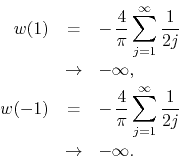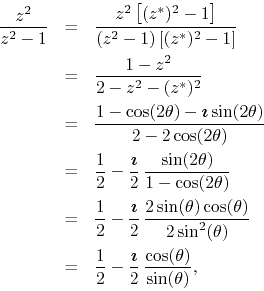Next: A Regular Cosine Series Up: Appendix: Examples of Center Previous: A Regular Sine Series
Consider the Fourier series of the two-cycle unit-amplitude sawtooth wave. As is well known it is given by the sine series
![\begin{displaymath}
S_{\rm s}
=
-\,
\frac{4}{\pi}
\sum_{j=1}^{\infty}
\frac{1}{2j}\,
\sin[(2j)\theta].
\end{displaymath}](img266.png)
The corresponding FC series is then
![\begin{displaymath}
\bar{S}_{\rm s}
=
-\,
\frac{4}{\pi}
\sum_{j=1}^{\infty}
\frac{1}{2j}\,
\cos[(2j)\theta],
\end{displaymath}](img267.png)
the complex ![]() series is given by
series is given by

and the complex power series ![]() is given by
is given by

The ratio test tells us that the disk of convergence of ![]() is the
unit disk. If we consider the inner analytic function
is the
unit disk. If we consider the inner analytic function ![]() within this
disk we observe that
within this
disk we observe that ![]() , as expected. We have for this function
, as expected. We have for this function

Being given by a monotonic series of step ![]() this function has two
dominant singularities, located at
this function has two
dominant singularities, located at ![]() and at
and at ![]() , where it diverges
to infinity, as one can easily verify,
, where it diverges
to infinity, as one can easily verify,

We must therefore use the two factors
![]() in the
construction of the center series,
in the
construction of the center series,
![\begin{eqnarray*}
C_{z}
& = &
-\,
\frac{4}{\pi}\,
\left(z^{2}-1\right)
\su...
... 1
-
\sum_{j=1}^{\infty}
\frac{1}{j(j+1)}\,
z^{2j}
\right].
\end{eqnarray*}](img272.png)
Unlike the original series, with coefficients that behave as ![]() (with
(with
![]() ), this series has coefficients that go to zero as
), this series has coefficients that go to zero as ![]() when
when
![]() , and therefore is absolutely and uniformly convergent to a
continuous function. This shows, in particular, that our evaluation of the
set of dominant singularities of
, and therefore is absolutely and uniformly convergent to a
continuous function. This shows, in particular, that our evaluation of the
set of dominant singularities of ![]() was in fact correct. We have
therefore for
was in fact correct. We have
therefore for ![]() the representation
the representation
![\begin{displaymath}
S_{z}
=
\frac{2}{\pi}\,
\frac{z^{2}}{z^{2}-1}
\left[
1
-
\sum_{j=1}^{\infty}
\frac{1}{j(j+1)}\,
z^{2j}
\right],
\end{displaymath}](img273.png)
with the singularities factored out and where the series involved is absolutely and uniformly convergent, and therefore converges much faster than the original one.
We may now take the real and imaginary parts of the ![]() series in
order to obtain faster-converging representation of the original DP
Fourier series and its FC series. We have on the unit circle
series in
order to obtain faster-converging representation of the original DP
Fourier series and its FC series. We have on the unit circle

and therefore
![\begin{eqnarray*}
S_{v}
& = &
\frac{1}{\pi}
\left[
1
-
\mbox{\boldmath$\i...
...j=1}^{\infty}
\frac{1}{j(j+1)}\,
\cos[(2j+1)\theta]
\right\}.
\end{eqnarray*}](img275.png)
The original DP function is given by the imaginary part,
![\begin{displaymath}
f_{\rm s}(\theta)
=
-\,
\frac{1}{\pi\sin(\theta)}
\left...
...1}^{\infty}
\frac{1}{j(j+1)}\,
\cos[(2j+1)\theta]
\right\},
\end{displaymath}](img276.png)
and the corresponding FC function
![]() is given by the real part,
is given by the real part,
![\begin{displaymath}
f_{\rm c}(\theta)
=
\frac{1}{\pi\sin(\theta)}
\left\{
\...
...1}^{\infty}
\frac{1}{j(j+1)}\,
\sin[(2j+1)\theta]
\right\}.
\end{displaymath}](img277.png)
Both of these series are absolutely and uniformly convergent.